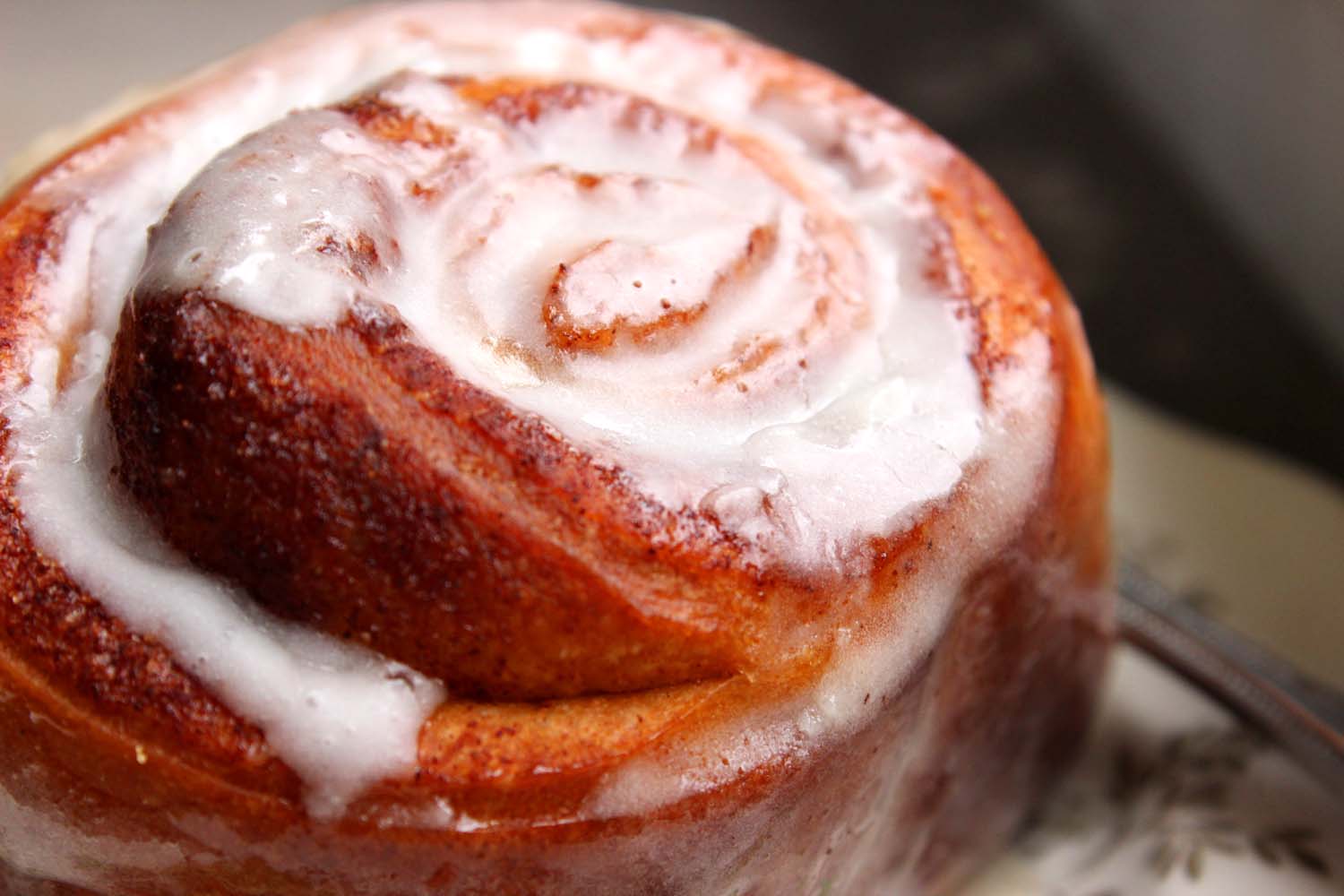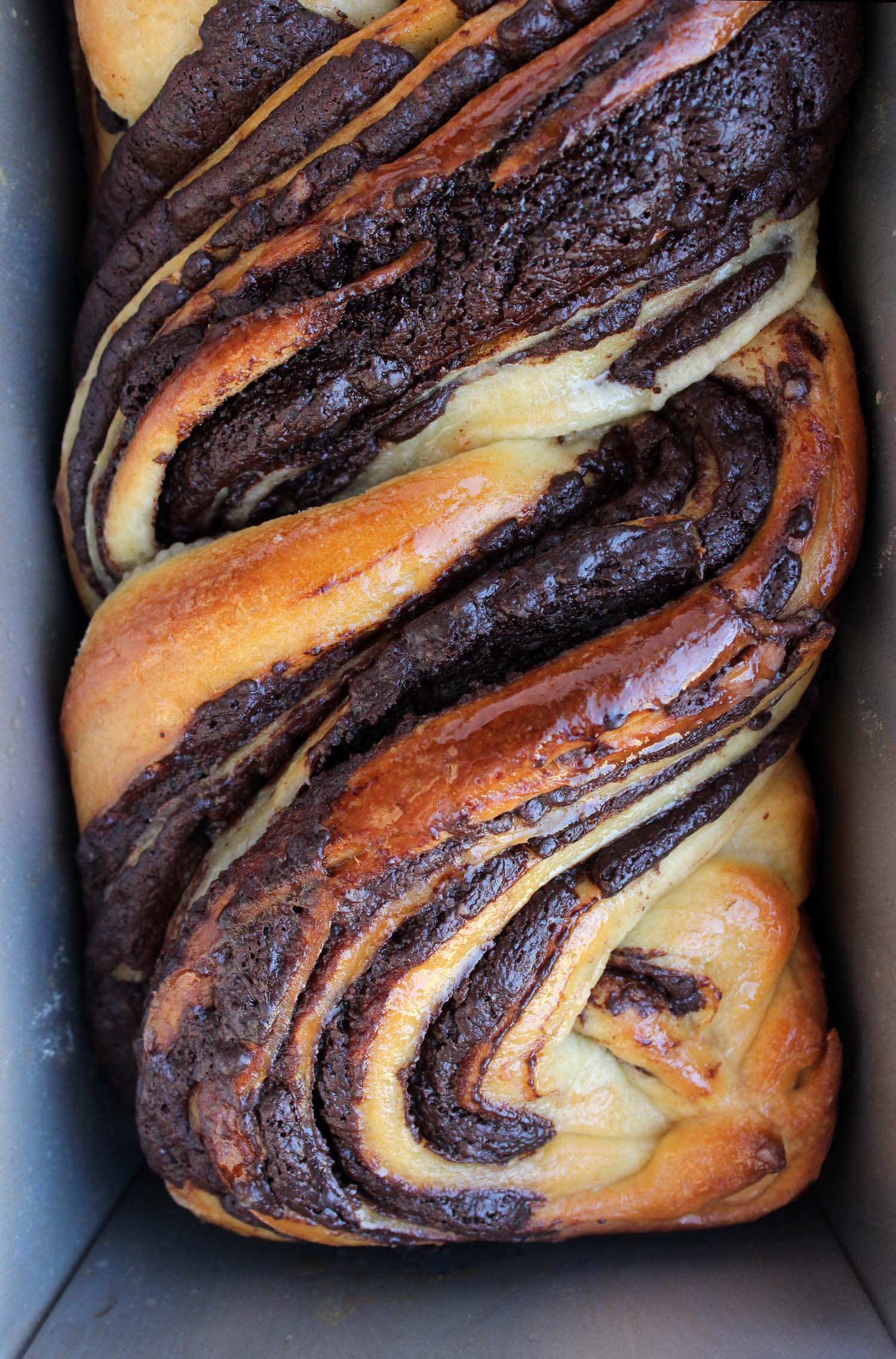Challah Cinnamon Rolls
Challah Cinnamon Rolls | Image: Laura Messersmith
One of the (many) benefits of marriage is experiencing familiar holidays through a different lens, trying on traditions that have been built over years, and at times contributing my own twist. Mike’s family has a long-standing tradition of marking special occasions with sticky buns acquired from a local, family-owned farm stand and bakery.
After I saw this recipe for No Knead Challah Cinnamon Rolls on the wonderful site Apt 2B Baking Co. written by the very talented Yossy Arefi (who else is super excited for her cookbook to be released in the spring!?) I started to wonder if I could replicate our usual breakfast treat, but one formed by my own hands. And what better time to make something special than for Christmas morning when a little extra effort is worth it?
Challah Cinnamon Rolls | Image: Laura Messersmith
I made challah during my bread baking class last winter and with a successful try at Deb Perelman’s Better Chocolate Babka earlier this fall I was feeling confident in my abilities. The simplicity of the ingredients – nearly everything listed is probably in your refrigerator or pantry right now – and the no-knead (aka no stand mixer) process means that this recipe truly requires very little other than the ability to measure, mix, and fold a little dough. There are zero fancy techniques or unusual pieces of equipment required. Perfect for cooking in an unfamiliar kitchen and a great starter recipe for the inexperienced bread baker.
But, I’m burying the lede: these cinnamon rolls are DELICIOUS and I can’t think of a more heavenly way to start the day, especially while they’re still warm out of the oven. I know Christmas is over, but the New Year is coming and with these cinnamon rolls 2016 would be off to a pretty spectacular start...
Challah Cinnamon Rolls | Image: Laura Messersmith
No-Knead Challah Cinnamon Rolls (yield: 12 cinnamon rolls)
Dough Ingredients:
4 cups bread flour
1 1/2 teaspoons active dry yeast
2 teaspoons fine sea salt
2 large eggs plus 1 large egg yolk at room temperature
1 egg white for egg wash
3/4 cup warm water
1/3 cup olive oil
1/4 cup honey
Filling Ingredients:
4 tablespoons unsalted butter, melted
1/3 cup granulated sugar
2 tablespoons ground cinnamon
pinch salt
Non-stick spray, for prepping the baking dish
Glaze Ingredients:
2 cups confectioner's sugar
1/3 cup sour cream
1 teaspoon vanilla extract
pinch salt
2-3 teaspoons whole milk, as needed
Mid-Day or Afternoon Before: Mixing & Folding the Dough
In a large bowl, whisk together the bread flour and sea salt. In a separate smaller bowl whisk together the eggs, honey, and olive oil. Set both aside while you proof the yeast. Place the warm water and active dry yeast in a measuring cup and stir together gently. Allow the yeast and water to sit at room temperature for 5-10 minutes until you see a foamy layer form on the top of the water, then the yeast is ready.
Stir both the yeast and honey mixtures into the flour with a rubber spatula until a wet, sticky dough forms. Cover the bowl with plastic wrap and rest at room temperature for 10 minutes.
Now begins the folding process, which you will perform five times at 30 minute intervals. Folding develops the gluten in the bread and gives it structure which allows it to trap air and rise when baked.
To fold the dough, peel back the plastic wrap and take hold of an edge folding it into the center and pressing down lightly with your fingers. Turn the bowl and repeat folding small pieces of the dough into the center for eight turns and folds total. It will look like a messy origami star. Then flip the dough so that the folds and seams are on the bottom. Cover the bowl tightly with the plastic, and let sit for 30 minutes at room temperature.
Repeat the all-around folding, flipping, covering, and resting four more times. Setting a timer in between and writing the steps on the plastic wrap, checking off each one as you go, will help keep the process moving and make sure you don’t miss a step or wait too long between folds.
The dough is sticky and doesn’t hold its shape especially well in the first stages, but trust that it will become firmer and more elastic allowing you to make proper folds in the later turns. By the final fold, the dough will be stretchy and you’ll see some small air bubbles.
After the fifth and final fold, reseal the plastic and place the bowl in the refrigerator overnight. Between 16-24 hours is ideal, any longer risks over-proofing the dough and will lead to flat, dense rolls. The over night resting time allows the yeast to slowly develop flavor in the dough and the volume will nearly double in size.
Early the Next Morning: Forming & Filling
Prepare a 9 x 13-inch baking dish with a light layer of non-stick spray.
Stir the sugar, cinnamon, and salt together in a small bowl. On a lightly floured surface roll the dough into an 18 x 12 inch rectangle about 1/2 inch thick. Leave a 1/2 inch border along one of the longer sides of the dough (this will be the outside seal of the roll) and brush the melted butter over the rest of the surface all the way to the edges. Sprinkle the cinnamon sugar over the butter.
Brush the 1/2 inch border left bare with a small amount of egg wash from the reserved egg white. Then roll the dough up into a tight log starting from the opposite long side toward the egg wash border. When the log is formed, lightly press the egg washed edge down and turn the log so that the seam is resting on the board.
Use a sharp knife to slice the log into 12 pieces about 1 1/2 inches wide and arrange them in the baking dish cut sides up spacing them evenly in the dish so that each has room to rise and spread.
Cover the baking dish with a dry kitchen towel and let the rolls rise at room temperature until puffy and almost doubled in size, about 2 hours.
Mid-Morning: Baking & Glazing
Position a rack in the center of the oven and preheat to 350 degrees F. Bake the rolls until golden and cooked through, about 25-30 minutes.
While the rolls are cooling, whisk the confectioner’s sugar, sour cream, vanilla extract, and salt in a medium bowl. Add the milk one teaspoon at a time until the glaze reaches your desired consistency, you’re looking for thick but pourable.
Drizzle the glaze over the warm cinnamon rolls and enjoy immediately.
Very lightly adapted from Apt 2B Baking Co.’s No Knead Challah Cinnamon Rolls by Yossy Arefi, which is adapted from Jessica Fechtor’s Five Fold Challah recipe in her book Stir.
Challah Cinnamon Rolls | Image: Laura Messersmith
Small Kitchen Friendly?
100% which is amazing. I used a large mixing bowl, medium mixing bowl, liquid measuring cup, dry measuring cups and spoons, and a rubber spatula to mix the dough. To bake and glaze I used a rolling pin, small bowl, pastry brush, bench scraper (or chef’s knife), 9 x 13 inch baking dish, and small spoon. Plastic wrap, a permanent marker, and a clean kitchen towel round out your kit. Use a ruler too if you want to be precise with your rolling and cutting.
The Verdict:
When I took the cinnamon rolls out of the oven all thoughts of food photography flew out of my head, and frankly I’m lucky there were any left by the time we were finished with breakfast. I had to abscond with the one cinnamon bun in these photos to snap some quick photos or risk having no evidence except a few crumbs and traces of glaze in the baking dish, which would have been an accurate statement about their deliciousness. The dough bakes up to a gentle crunch on the outside while maintaining that fluffy stretch inside; the cinnamon is warm but not too spicy, and the glaze, kept in check by its sour cream base, sweetens the whole concoction. Incredible.
Challah Cinnamon Rolls | Image: Laura Messersmith








